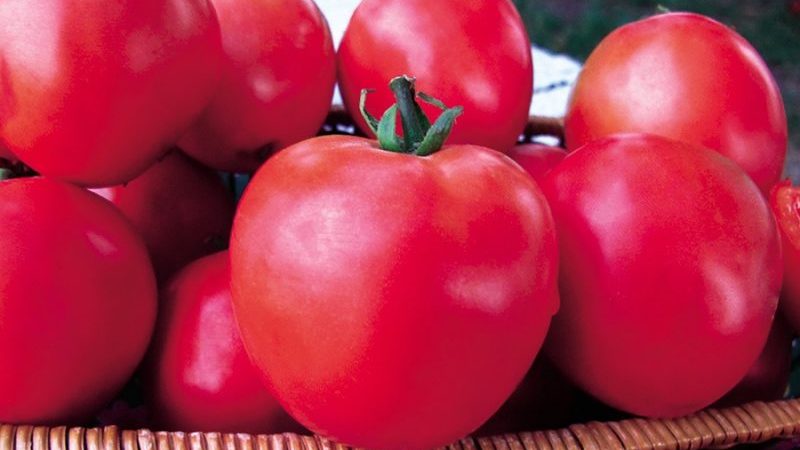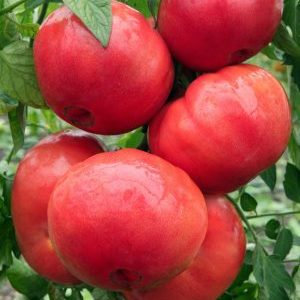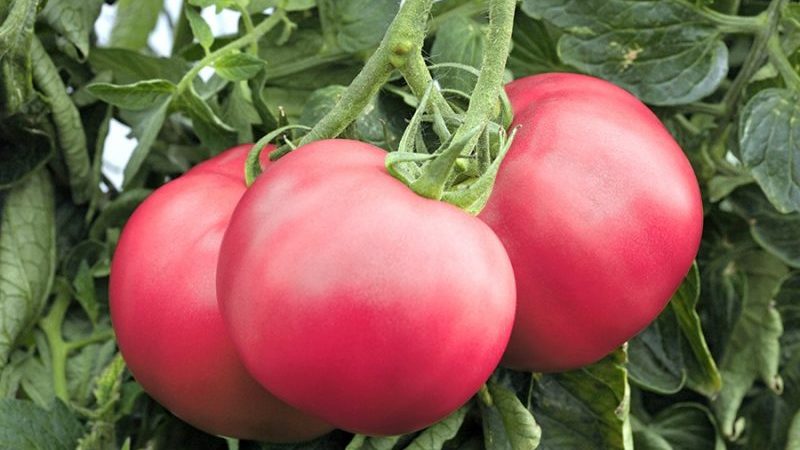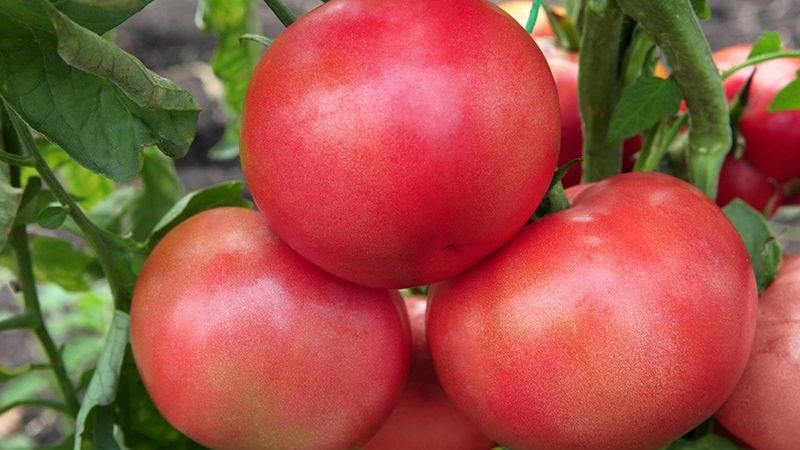A series of tomatoes "Raspberry Miracle": why are they so good, why they should be grown and how to do it right
Tomatoes are useful, have medicinal properties, and are tasty when fresh and canned. However, the culture itself is capricious, it is affected by diseases. In the climatic conditions of our country, you will have to work hard to have a good harvest.
From the article you will find out what this group of hybrids is - the Raspberry Miracle, and why you will always be with them with the tomato harvest.
The content of the article
Description
Tomatoes Raspberry Miracle - mid-early group of hybrids. Bred by the "Gardens of Russia" company. The fruits are large, ribbed, reaching 600 g.
The group of hybrids is unpretentious, versatile: suitable for open ground and greenhouses. High productivity is characteristic. Gardeners collect 10-14 kg of tasty fruits from 1 sq. m. The grown fruits are used for the preparation of salads, sauces, soups, side dishes, snacks. Tomato juice from ripe fleshy fruits is tasty.

Subspecies of tomatoes included in the Raspberry Miracle series
Breeders have created several subspecies of the Raspberry Miracle. They have similar characteristics, but have different ripening periods: Raspberry Sunset, Raspberry Wine and Bright Robin are early ripening, Raspberry Paradise and Berry-raspberry are mid-season.
Raspberry Wine and Raspberry Sunset grow well in greenhouses, reaching a height of 2 m, they need pinching... Hybrids Raspberry Paradise, Berry-Raspberry, Bright Robin grow well in the open field. All have round, fleshy fruits weighing 200-500 g. The first fruits are harvested in 90-100 days.
Distinctive features
The main difference is high yield. The height of the bush is 1.5-2 m, which is why the plants need a garter.
The most important property for which the hybrids were nicknamed "a real miracle" - tomatoes do not get sick, even the scourge of our gardens late blight bypasses them.
Fruit characteristics, yield
Tomatoes grow smooth, fleshy, bright red, for which they got their name. Weigh from 200 to 600 g.
When ripe, tomatoes do not crack, they have a wonderful taste. The seeds have a high germination capacity, after several years they do not lose productivity.
How to grow seedlings
Tomatoes of the Raspberry Miracle series are unpretentious in care, but to get a high yield, you should know the simple rules of care. They are grown in all regions of our country, best of all - through seedlings.
Seed preparation
First, you should separate the good seeds from the bad ones. To do this, they are soaked for 10 minutes in a solution of salt (1 tsp) and water (250 ml). The seeds that have risen to the surface are thrown away (they are empty), and those that have sunk to the bottom are used for subsequent planting.
Then they are disinfected with a pink solution of potassium permanganate, aloe juice or garlic infusion. More effective means for etching are brilliant green solution (1 ml of 1% pharmaceutical preparation per 100 ml of water) and undiluted chlorhexidine solution. The seeds are kept for 30 minutes, then washed.
To increase germination energy, germination rate, increase germination rate, use growth stimulants: special preparations "Epin" or "Zircon", homemade solutions. Take 1⁄2 nicotinic acid tablet, 1/2 succinic acid tablet, 1⁄4 ascorbic acid, half a glycine tablet and dilute in half a liter of water.You can stimulate seed germination by soaking them in warm water for a day.
To form resistance to temperature changes, the seeds are hardened. The damp seeds are placed in a damp cloth and placed in the refrigerator on the top shelf at 2-4 ° C overnight. During the day, the seeds are kept at room temperature. This operation is carried out over several days.
Attention! If the seeds are coated, granulated or coated with colored glaze, they do not require additional preparation. They are sown dry.
Capacity and soil
For seedlings, take purchased soil or peat cups. You can make the potting mix yourself. It should be light, fertile, from the same proportions of sod land, peat, sand. Self-prepared soil must be disinfected using potassium permanganate, steaming and calcining to kill pathogens.
Soil containers are also disinfected. Seedling boxes are taken shallow, 12-15 cm high.
Sowing
Sow seeds into prepared potting mix in early March.
The seeds of this group of hybrids are not recommended to be sown deeper than 1-1.5 cm. The seedling boxes are covered with glass or foil and placed in a warm, dark place. The ground must be moist.
Growing and care
To obtain strong healthy seedlings, it is necessary to create the following conditions:

- Maintain the room temperature around 20 ° C.
- Ventilate the room regularly, but do not create drafts.
- Regularly to water, keep the soil moist. But remember that excess moisture is harmful to tomato seedlings, leads to rotting of young roots.
- Drizzle with water at room temperature, settled for a day.
- Create lighting throughout the morning.
With the appearance of the first leaves, the seedlings are picked, seated in separate containers. Weakened, frail seedlings feed solution "Nitrofoski".
A few weeks before transplanting to a permanent place, the seedlings are hardened. She is taken out to the balcony, loggia. The time spent in the fresh air is gradually increased.
How to grow tomatoes
After the end of the morning and night frosts at the end of May, the seedlings are planted in a permanent place, which is chosen in the fall. Crop rotation and illumination are taken into account. Before planting, the soil is loosened, dug up, manure and humus are added. Then cover with foil to better warm the soil and maintain the desired moisture level.
Tomatoes are planted in warm, but cool weather, early in the morning or in the evening.
Landing
Tomatoes of the Raspberry Miracle group of hybrids are planted in the ground after 60 days. The seedlings should have 5-6 leaves. They are planted in a checkerboard pattern, the distance between the bushes is 50 cm, in the aisles of about 60 cm. So it is easier to care for them, to harvest, the sun illuminates the plants better. Be sure to install shrub supports immediately after transplanting.
Seedlings are placed in the holes along with an earthen clod. The extra roots are pinched. Peat pots with tomatoes are placed in the hole. Then they cover it, the soil is compacted and watered, mulched with peat.
Care

Only with proper care can you get a high yield of Raspberry Miracle hybrids. During the growing season, tomatoes need regular watering, feeding, weeding. Water the plant once a week, but abundantly, with warm water heated in the sun.
Before the formation of ovaries, use about 4 liters of water under the root. During the appearance of fruits, the plants are watered twice a week with 3 liters of water.
Loosen regularly so that no crusts appear on the surface of the soil, feed the roots. Experts recommend forming 2 stems. Remove stepsons, pinch the shoots every week.
Reference. Plants grow strongly over the season, a permanent garter is recommended for them.
The plant is responsive to feeding, it is recommended to carry it out 3-4 times during the summer. Use superphosphate, peat, manure, ash for root application.The first feeding is carried out with "Nitrofoskoy" 21 days after planting - 1 tbsp. l. preparation for 10 liters of water. For the second feeding, use 20 g of superphosphate and potassium salt per 10 liters of water.
Features of cultivation and possible difficulties
Tomatoes love light. In case of insufficient illumination, the growth and development of plants slows down, fruits are not formed. This problem often occurs when growing seedlings: seedlings begin to stretch, the stems become thin. To prevent this from happening, do not allow thickened plantings.
Observe the optimum humidity. With a lack of moisture in the soil, the leaves curl, the fruits are affected by apical rot.
Sharp changes in soil moisture during the ripening period do not affect the group of hybrids: the fruits of the Raspberry Miracle do not crack.
Lack of moisture during flowering leads to the fall of flowers and ovaries. With an excess of moisture before flowering, the plant grows vigorously. The bushes are tied to supports so that they do not break when the fruit ripens.
Diseases and pests
Tomatoes Raspberry Miracle are resistant to disease, not susceptible to late blight. But one should not forget about prevention.
Observe the crop rotation, do not plant after nightshade crops, next to potatoes. Thin plants, remove lower leaves, weeds, loosen the soil. Treat with fungicides.
For insect control-pests use insecticides, folk remedies: ash, onion and garlic infusions, tobacco. To combat the fungus, the bushes are sprayed with Bordeaux liquid, copper sulfate, special chemical and biological agents.
The nuances of growing in open ground and in a greenhouse
Growing tomatoes outdoors produces healthier and stronger fruits. Infection with diseases of the nightshade is excluded.
Seedlings are planted in a greenhouse after a month and a half from germination, avoiding "pulling" the plants.
The row spacing is 80 cm, the distance between tomatoes is 50-60 cm when growing tomatoes in 1 stem, and 70 cm when growing in 2 stems. Avoid thickening of the planting to provide light and air ventilation.
If fungal infections appear, stop watering... Severely affected plants are removed, the rest are treated with fungicidal preparations. The most effective antifungal agents for plants are "Fundazol", "Maxim", "Skor".
The greenhouse should be ventilated after each watering, avoiding excess moisture and dryness of the soil under the bushes. Otherwise, the plants will not grow well, the leaves will curl and wither.
Harvesting and application of the crop
Large tomatoes are harvested at the stage of milk ripeness. They ripen well, and new ovaries appear on the bushes, the rest of the fruits gain weight. At the stage of blanche ripeness, all fruits prepared for storage are removed. Ripe tomatoes are not stored for a long time, they are consumed for several days or they are allowed to harvest.

Harvesting is carried out in dry weather, without breaking the stalk for better storage. Harvested every 3-5 days. If the temperature is below + 7 ... + 8 ° C, the whole crop is harvested.
Raspberry Miracle - salad group of hybrids. Juice is obtained from it, the second vegetable dishes, sauces are prepared, canned in slices, used for salads and soup dressings.
Advantages and disadvantages
The Raspberry Miracle has several benefits:
- High productivity.
- Delicious large fruits, easy to transport.
- Abundant ovary, resistance to temperature and humidity changes.
- Stores well for about two months.
The main disadvantage is that it belongs to hybrids and does not produce seeds. The price of seeds is high, they are sold in series: 3-5 subspecies together.
Farmers reviews
The number of fans of the Raspberry Miracle group of hybrids is growing from year to year. Buyers like the rich taste and juiciness of the fruit. Most of the reviews about the group of hybrids “Raspberry Miracle. Gardens of Russia ”are positive.
Valentina, Yekaterinburg: “I have been growing tomatoes Raspberry Miracle for several years. The seedlings are friendly, the seedlings are healthy.They tolerate the cold Siberian summer well, do not get sick. I tie up the bushes, my stepson. The fruits are large, beautiful, tasty. Ripen gradually. Last summer they raised a giant - a tomato weighing 600 g. ”
Lyudmila, Korolev: “This summer I grew Raspberry Miracle tomatoes for the first time. There was no thought of a huge harvest. But she was delighted and amazed - clusters of large fruits hung on the supports. We ate tomatoes ourselves, offered them to friends, rolled up cans: lecho, tomato puree, juice. I advise! "
Natalia, Miass: “I planted the Raspberry Miracle on the site. The taste is excellent, the yield is impressive. A garter and pinning are required. Does not suffer from late blight, although the summer was rainy. I will plant again. "
Conclusion
Tomato Raspberry Miracle is an excellent result of the work of Russian breeders.
Hundreds of gardeners liked the tasty fruits. A group of hybrids is a real miracle: unpretentious, pleasing with a high yield, not amazed late blight, the fruits do not crack and are well stored.